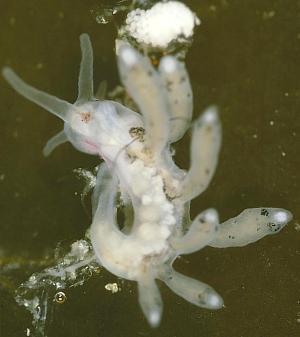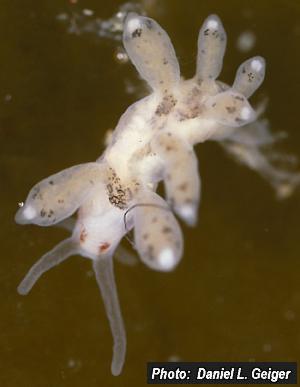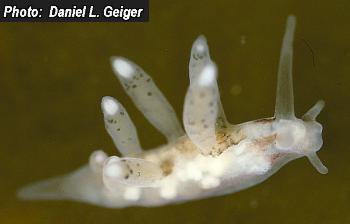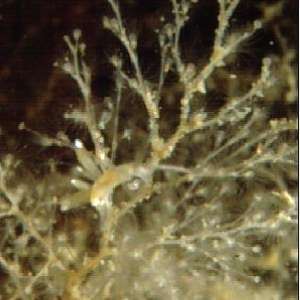

Tergipes tergipes
(Forskal, 1775)
Order: NUDIBRANCHIA
Suborder: AEOLIDINA
Family: Tergipedidae
DISTRIBUTION
Widely distributed throughout the Atlantic Ocean from Iceland and Norway to the Mediterranean, and from Brazil to North America.
PHOTO
St. Kilda, Outer Hebrides, Scotland, 1993. 2-3mm long. PHOTOS: Daniel Geiger.
Small aeolid growing to about 8mm. each branch of the digetsive gland leads to only a single ceras. Feeds on a wide variety of hydroids and can be locally very abundant. Swennen (1959) reports population densities of 500 per square meter at a site in Holland.
References:
• Swennen, C. (1959) The Netherlands coastal waters as an environment for Nudibranchia. Basteria, 23: 56-62.
• Thompson, T.E. & Brown, G.H. (1984) Biology of Opisthobranch Molluscs, Vol 2. Ray Society: London.
Rudman, W.B., 2000 (December 31) Tergipes tergipes (Forskal, 1775). [In] Sea Slug Forum. Australian Museum, Sydney. Available from http://www.seaslugforum.net/find/tergterg
Related messages
Tergipes tergipes from the Netherlands
May 8, 2006
From: John de Jong

Herewith some pics of Tergipes tergipes, some with eggs.
Locality: Dreischor, 5 metres, Netherlands, Grevelingen, 1-4-2006, Salt water without current. Length: 10 mm. Photographer: John de Jong.
John de Jong
john@jojodive.nl


Dear John,
Thanks for those photos of Tergipes tergipes on its food hydroid. I suspect it is a species of Obelia.
Best wishes,
Bill Rudman
Tergipes tergipes image
January 2, 2001
From: Daniel Geiger

Hi Bill,
You were asking for a clearer picture of Tergipes tergipes. I have shot some in St. Kilda [Outer Hebrides, Scotland in 1993] with a 50 mm macro lens on a bellows plus the unique Olympus 65-113 mm variable extension tube. It provided approximately a magnification of 10:1 with cropping giving an other factor of 1.5 - 2x. (specimen size 2-3 mm.) Depth of field is approximately a few angstroms. With f/8 I exceeded maximum advantageous f-stop [fmax = 32/(m + 1) hence at 10x fmax = 32/11 = f/3 !] by 3 f-stops, which is just about at the pain level, because some blurring due to diffraction becomes obvious, but there is at least some depth of field. Anyway hope the shots suit the purpose.
Best wishes
Daniel
dgeiger@nhm.org


Dear Daniel,
Thanks for this great New Year's present. I excuse the blurring - when the animal is only 2-3mm and there are cerata sticking out at all angles I find it amazing that you have got so much in focus.
Best wishes,
Bill Rudman.
Tergipes tergipes from the Netherlands
September 1, 1999
From: Peter H. van Bragt

Dear Bill,
Here is a photo of Tergipes tergipes to add to the Netherlands' List.
Location: Zoetersbout, de Oosterschelde, the Netherlands
With best regards
Peter H. van Bragt
Peter.vanBragt@ftn.hsbrabant.nl
van Bragt, P.H., 1999 (Sep 1) Tergipes tergipes from the Netherlands. [Message in] Sea Slug Forum. Australian Museum, Sydney. Available from http://www.seaslugforum.net/find/1265Thanks Peter,
Hopefully we can get a clearer picture of this tiny aeolid, characterised by the single ceras in each 'row'.
Best wishes,
Bill Rudman.
